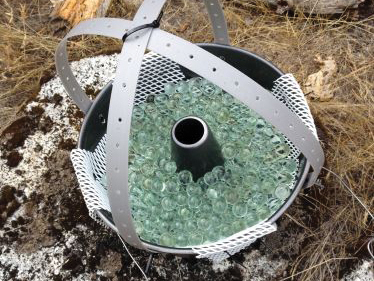
Researchers from the Southern Sierra Critical Zone Observatory have discovered an influx in the amount of phosphorus due to dust coming from both the Gobi Desert (located in Northern China) and from the California Central Valley. This discovery was made by a team of scientists from the observatory, including scientists from the University of California, Riverside, such as Dr. Emma Aronson, an assistant professor in the Department of Plant Pathology and Microbiology. Other researchers from UC Riverside who have contributed to this publication include Chelsea Carey, a post-doctoral researcher who formerly worked in Aronson’s lab, as well as Jon Botthoff, a field technician involved at the university’s Center for Conservation Biology.
Samples were taken from the Northern California Sierra Mountains around the summer growing season, from approximately mid-May through October, for study. After taking the dust’s isotopic signatures from each of the locations from which the samples were taken, minerals such as phosphorus and calcium were found, suggesting that some of the dust may originate from the Gobi Desert and the Central Valley.
Aronson explained, “We saw different isotopic signatures, telling us that there’s different mixtures, a different amount of Gobi Desert (dust) versus other sources.” They came to this conclusion after comparing it to the soil and dust samples from other locations that would match their range in percentage similarities. The team took the dust samples from different locations, each at different elevations and ecosystems on the Sierra Nevada mountains and evaluated the origins of the dust and its contents. According to the study, dust from Asian sources comprises approximately 18 to 45 percent of dust deposition in the Sierra Nevada.
These recent findings have alerted the team about the potential effects the dust may have on the California ecosystem through the quantification of the dust on the trees’ bedrocks and therefore, the amount of nutrients it carries to contribute to the trees. One type of tree in particular is the sequoia tree in the Sierra region where the team has found a substantial amount of nutrients in its bedrock. In this case, the mountains have shown an increase in a number of nutrients. One particular element is phosphorus, a mineral that is quite scarce in its bedrock due to natural weathering and soil erosion. Finding these nutrients in these dusts is essential to understanding the ecosystem’s needs as it develops over time with climate change and how it would receive these nutrients through these natural processes.
However, several factors had to be accounted for in these findings in order to accurately evaluate the changes in the soil as well as the amount of nutrients it carries and how they came to discover their findings. With the help of previous publications in concern with the Sierra region, the team has gathered information about the Sierra Nevada region where these factors can be honed into their studies. The team has connected how the climate could affect the dust patterns and the concentration of dust in that area.
These findings provide a segue into seeing the effects that dust and other traveling sediments have on the environment in that particular region while understanding how the climate changes affect the patterns they have seen so far. Dr. Aronson pointed out, “Over time, there’s other elevations, we were able to see that as the dry season in California progressed, (it) just so happens that around the same time that year, the Gobi Desert is having fewer and fewer dust storms.”
As for now, the team is hoping to expand their research by finding out more about the microbial dispersal found in the soil in the Sierra Nevada regions. Studies like this have been beneficial in understanding the geological and environmental community in terms of climate predictions to these types of environmental responses.
Alex Miller, a first-year environmental sciences major spoke on this topic saying, “This discovery has shown us another example of the environmental interconnectedness of the world.” He continued, “This evidence (of the Gobi Dust found in the Sierra mountains) is evidence supporting a major theme for students studying any science major, considering that environmental science is inherently interdisciplinary.”








